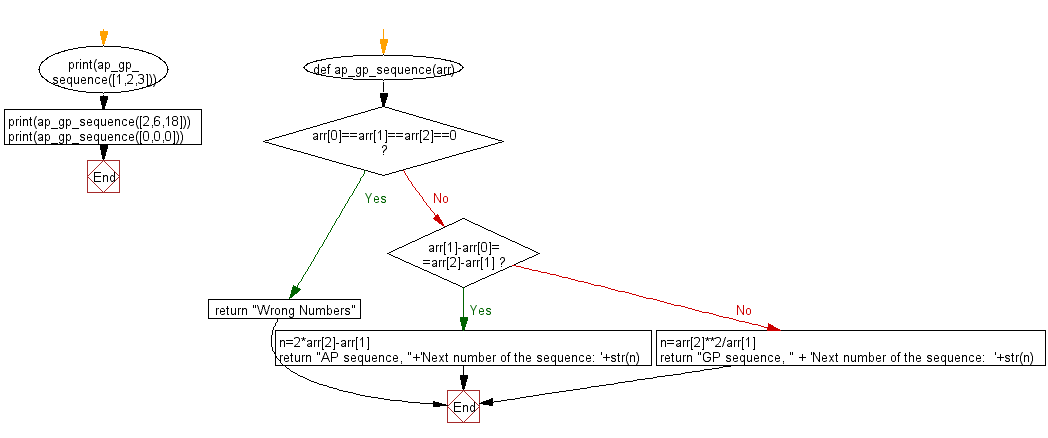Python: Find the type of the progression and the next successive member of a given three successive members of a sequence
Progression Type and Next
Write a Python program to find the type of the progression (arithmetic progression / geometric progression) and the next successive member of the three successive members of a sequence.
According to Wikipedia, an arithmetic progression (AP) is a sequence of numbers such that the difference of any two successive members of the sequence is a constant. For instance, the sequence 3, 5, 7, 9, 11, 13, . . . is an arithmetic progression with common difference 2. For this problem, we will limit ourselves to arithmetic progression whose common difference is a non-zero integer. On the other hand, a geometric progression (GP) is a sequence of numbers where each term after the first is found by multiplying the previous one by a fixed non-zero number called the common ratio. For example, the sequence 2, 6, 18, 54, . . . is a geometric progression with common ratio 3. For this problem, we will limit ourselves to geometric progression whose common ratio is a non-zero integer.
Sample Solution:
Python Code:
# Define a function 'ap_gp_sequence' that identifies whether a given sequence is an Arithmetic Progression (AP) or Geometric Progression (GP).
def ap_gp_sequence(arr):
# Check if the first three elements are all zero.
if arr[0] == arr[1] == arr[2] == 0:
return "Wrong Numbers" # If all three are zero, it's not a valid sequence.
else:
# Check if the sequence is an AP (Arithmetic Progression).
if arr[1] - arr[0] == arr[2] - arr[1]:
n = 2 * arr[2] - arr[1]
return "AP sequence, " + 'Next number of the sequence: ' + str(n)
else:
# If not an AP, assume it's a GP (Geometric Progression).
n = arr[2] ** 2 / arr[1]
return "GP sequence, " + 'Next number of the sequence: ' + str(n)
# Test the 'ap_gp_sequence' function with different sequences and print the results.
print(ap_gp_sequence([1, 2, 3]))
print(ap_gp_sequence([2, 6, 18]))
print(ap_gp_sequence([0, 0, 0]))
Sample Output:
AP sequence, Next number of the sequence: 4 GP sequence, Next number of the sequence: 54.0 Wrong Numbers
Explanation:
The above Python code defines a function named "ap_gp_sequence()" that determines whether a given sequence is an Arithmetic Progression (AP) or a Geometric Progression (GP). Here's a brief explanation:
- Function Definition:
- def ap_gp_sequence(arr):: Define a function named "ap_gp_sequence ()" that takes a list of three numbers 'arr' as input.
- Check for Special Case:
- if arr[0] arr[1] arr[2] == 0:: Check if all three elements in the sequence are zero.
- If true, return "Wrong Numbers" since this is not a valid case for an AP or GP.
- Determine AP or GP:
- if arr[1] - arr[0] == arr[2] - arr[1]:: Check if the differences between consecutive elements are equal.
- If true, it's an AP sequence.
- Calculate the next number in the sequence (n) using the AP formula: 2 * arr[2] - arr[1].
- If false, assume it's a GP sequence.
- Calculate the next number in the sequence (n) using the GP formula: arr[2] ** 2 / arr[1].
- Return Result:
- Return a formatted string indicating whether it's an AP or GP sequence and the next number in the sequence.
- Function Testing:
- Test the ap_gp_sequence function with different sequences:
- print(ap_gp_sequence([1, 2, 3])): Test with an AP sequence.
- print(ap_gp_sequence([2, 6, 18])): Test with a GP sequence.
- print(ap_gp_sequence([0, 0, 0])): Test with a special case where all elements are zero.
Visual Presentation:
Flowchart:

For more Practice: Solve these Related Problems:
- Write a Python program to determine the common difference or ratio in a given arithmetic or geometric progression.
- Write a Python program to check whether a provided sequence is arithmetic, geometric, or neither.
- Write a Python program that, given an arithmetic or geometric progression, generates the next five numbers in the sequence.
- Write a Python program to calculate the deviation from a perfect arithmetic or geometric progression for a given sequence.
Go to:
Previous: Write a Python program to compute the summation of the absolute difference of all distinct pairs in an given array (non-decreasing order).
Next: Write a Python program to print the length of the series and the series from the given 3rd term , 3rd last term and the sum of a series.
Python Code Editor:
Have another way to solve this solution? Contribute your code (and comments) through Disqus.
What is the difficulty level of this exercise?
Test your Programming skills with w3resource's quiz.
